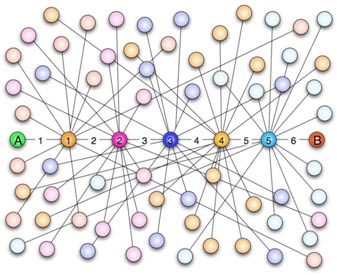“六度空间”理论又称作“六度分隔(Six Degrees of Separation)”理论。这个理论可以通俗地阐述为:“你和任何一个陌生人之间所间隔的人不会超过六个,也就是说,最多通过五个人你就能够认识任何一个陌生人。”如图1所示。

图1 六度空间示意图
“六度空间”理论虽然得到广泛的认同,并且正在得到越来越多的应用。但是数十年来,试图验证这个理论始终是许多社会学家努力追求的目标。然而由于历史的原因,这样的研究具有太大的局限性和困难。随着当代人的联络主要依赖于电话、短信、微信以及因特网上即时通信等工具,能够体现社交网络关系的一手数据已经逐渐使得“六度空间”理论的验证成为可能。
假如给你一个社交网络图,请你对每个节点计算符合“六度空间”理论的结点占结点总数的百分比。
输入格式:
输入第1行给出两个正整数,分别表示社交网络图的结点数N(1,表示人数)、边数M(≤,表示社交关系数)。随后的M行对应M条边,每行给出一对正整数,分别是该条边直接连通的两个结点的编号(节点从1到N编号)。
输出格式:
对每个结点输出与该结点距离不超过6的结点数占结点总数的百分比,精确到小数点后2位。每个结节点输出一行,格式为“结点编号:(空格)百分比%”。
输入样例:
10 9
1 2
2 3
3 4
4 5
5 6
6 7
7 8
8 9
9 10
输出样例:
1: 70.00% 2: 80.00% 3: 90.00% 4: 100.00% 5: 100.00% 6: 100.00% 7: 100.00% 8: 90.00% 9: 80.00% 10: 70.00%
我的答案
1 #include <stdio.h> 2 #include <stdlib.h> 3 #include <unistd.h> 4 5 #define MaxVertexMax 10000 /* 最大顶点数设为100 */ 6 #define INFINITY 65535 /* 设为双字节无符号证书的最大值 */ 7 #define MaxSize 330000 8 9 typedef int Vertex; 10 typedef int WeightType; 11 typedef char DataType; 12 13 typedef struct ENode *PtrToENode; 14 struct ENode { 15 Vertex V1, V2; 16 WeightType Weight; 17 }; 18 typedef PtrToENode Edge; 19 20 typedef struct GNode *PtrToGNode; 21 struct GNode { 22 int Nv; 23 int Ne; 24 WeightType G[MaxVertexMax][MaxVertexMax]; 25 DataType Data[MaxVertexMax]; 26 }; 27 typedef PtrToGNode MGraph; 28 29 struct QNode { 30 Vertex Data[MaxSize]; 31 int rear; 32 int front; 33 }; 34 typedef struct QNode *Queue; 35 36 MGraph CreateGraph(int VertexNum) 37 { 38 Vertex V, W; 39 MGraph Graph; 40 41 Graph = (MGraph)malloc(sizeof(struct GNode)); 42 Graph->Nv = VertexNum; 43 Graph->Ne = 0; 44 45 for(V=0;V<=Graph->Nv;V++) 46 for(W=0;W<=Graph->Nv;W++) 47 Graph->G[V][W] = INFINITY; 48 49 return Graph; 50 } 51 52 void InsertEdge(MGraph Graph, Edge E) 53 { 54 Graph->G[E->V1][E->V2] = E->Weight; 55 Graph->G[E->V2][E->V1] = E->Weight; 56 } 57 58 MGraph BuildGraph() 59 { 60 MGraph Graph; 61 Edge E; 62 Vertex V; 63 int Nv, i; 64 65 scanf("%d", &Nv); 66 Graph = CreateGraph(Nv); 67 scanf("%d ", &(Graph->Ne)); 68 if(Graph->Ne != 0) { 69 E = (Edge)malloc(sizeof(struct ENode)); 70 E->Weight = 1; 71 for(i=0;i<Graph->Ne;i++) { 72 scanf("%d %d ", &E->V1, &E->V2); 73 InsertEdge(Graph, E); 74 } 75 } 76 77 for(V=0;V<Graph->Nv;V++) 78 scanf(" %c", &(Graph->Data[V])); 79 80 return Graph; 81 } 82 83 void PrintGraph(MGraph Graph) 84 { 85 Vertex V, W; 86 printf("Graph: "); 87 for(V=1;V<=Graph->Nv;V++) { 88 for(W=1;W<Graph->Nv;W++) 89 printf("%5d " ,Graph->G[V][W]); 90 printf(" "); 91 } 92 printf("----------------------- "); 93 } 94 95 //广度优先 96 int IsEmpty(Queue Q) 97 { 98 return (Q->rear == Q->front); //1:empty 0:not empty 99 } 100 101 void AddQ(Queue PtrQ, Vertex item) 102 { 103 if((PtrQ->rear+1)%MaxSize == PtrQ->front) { 104 printf("Queue full"); 105 return; 106 } 107 PtrQ->rear = (PtrQ->rear+1)%MaxSize; 108 PtrQ->Data[PtrQ->rear] = item; 109 } 110 111 Vertex DeleteQ(Queue PtrQ) 112 { 113 if(PtrQ->front == PtrQ->rear) { 114 printf("Queue empty"); 115 return -1; 116 } else { 117 PtrQ->front = (PtrQ->front+1)%MaxSize; 118 return PtrQ->Data[PtrQ->front]; 119 } 120 } 121 122 void Visit(Vertex V) 123 { 124 printf(" %d", V); 125 } 126 127 int IsEdge(MGraph Graph, Vertex V, Vertex W) 128 { 129 return Graph->G[V][W]<INFINITY?1:0; 130 } 131 132 int BFS(MGraph Graph, Vertex S, int *Visited) 133 { 134 Queue Q; 135 Vertex V, W; 136 int count = 0, level = 0, last = S, tail = 0; 137 Q = (Queue)malloc(sizeof(struct QNode)); 138 139 // Visit(S); 140 Visited[S] = 1; 141 count++; 142 AddQ(Q, S); 143 144 while(!IsEmpty(Q)) { 145 V = DeleteQ(Q); 146 for(W=1;W<=Graph->Nv;W++) { 147 if(!Visited[W] && IsEdge(Graph, V, W)) { 148 // Visit(W); 149 Visited[W] = 1; 150 AddQ(Q, W); 151 count++; 152 tail = W; //下一层最后一个 153 } 154 } 155 if(V == last) { 156 level++; 157 last = tail; 158 } 159 if(level == 6) break; 160 } 161 162 return count; 163 } 164 165 int main() 166 { 167 MGraph Graph; 168 int *Visited, i, j; 169 int count = 0; 170 Graph = BuildGraph(); 171 Visited = (int *)malloc(sizeof(int)*(Graph->Nv+1)); 172 for(i=0;i<=Graph->Nv;i++) 173 Visited[i] = 0; 174 175 // PrintGraph(Graph); 176 177 for(i=1;i<=Graph->Nv;i++) { 178 if(!Visited[i]) { 179 count = BFS(Graph, i, Visited); 180 // printf(" count %d ", count); 181 printf("%d: %2.2f% ", i, (float)count/Graph->Nv*100); 182 for(j=0;j<=Graph->Nv;j++) 183 Visited[j] = 0; 184 } 185 } 186 return 0; 187 }